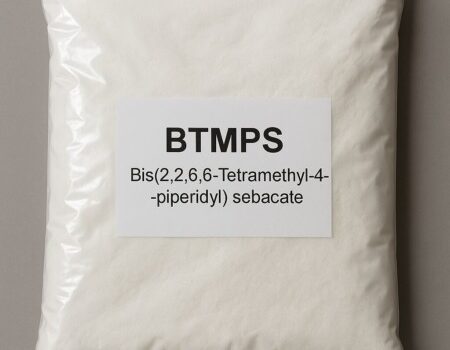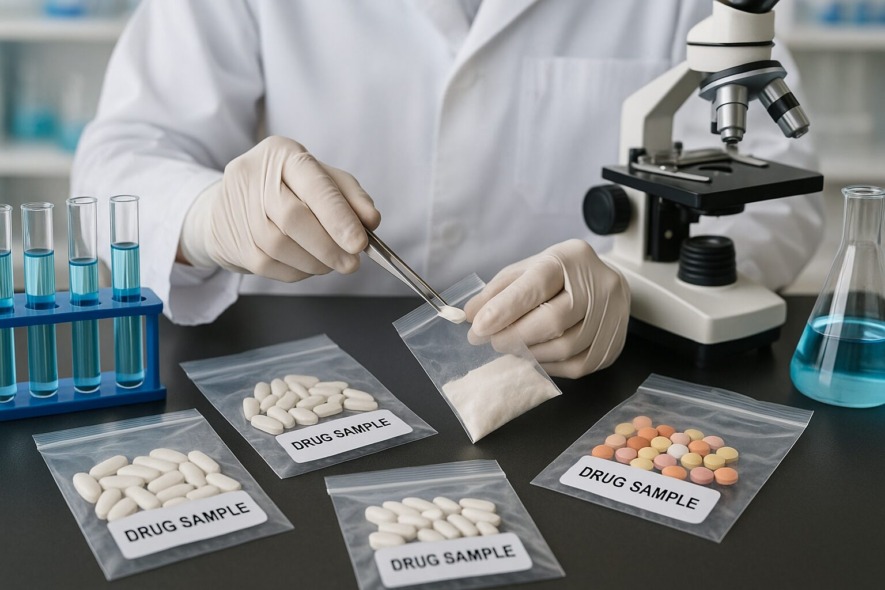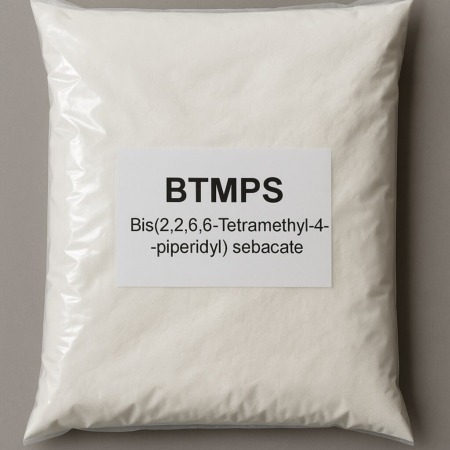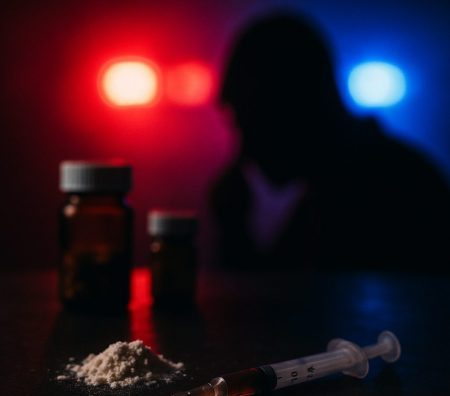Table of Contents
- What is BTMPS?
- The recent appearance of BTMPS in fentanyl and illicit drug supplies
- BTMPS now increasingly found in street drugs in the Midwest
- Is BTMPS a drug?
- Why is BTMPS being added to opioids?
- So what’s the problem with BTMPS in my drugs?
- Is there a way to detect if there’s BTMPS in my drugs?
- The bigger problem: What BTMPS reveals about the drug supply.
- Get Help With Drug or Alcohol Misuse
What is BTMPS?
BTMPS is an acronym for the chemical compound bis(2,2,6,6-tetramethyl-4-piperidyl) sebacate. Used primarily as a coating for plastic, to protect the product from degenerative UV rays, it is also used often as an adhesive or sealant. Until very recently, use of BTMPS was limited to the manufacturing industry.
The recent appearance of BTMPS in fentanyl and illicit drug supplies
In a strange and alarming new development, BTMPS has been appearing in drug samples nationwide. From June through October of 2024, researchers at UCLA tested samples of drugs marked as fentanyl. Samples were obtained from drug testing sites across the United States and from Puerto Rico. A shocking total of twenty percent of drugs tested contained BTMPS, with contamination rates in California as high as fifty six percent. The majority of samples tested had more BTMPS than fentanyl, with some containing ten times more BTMPS than fentanyl.
Adding to the intrigue, the compound appeared suddenly, and nearly simultaneously across the United States. Samples tested in June revealed twelve percent of drugs sold as fentanyl to contain BTMPS. By September, that number jumped to forty four percent of drugs tested. That represents an astounding two hundred and fifty two percent increase of BTMPS being found in drugs across the entire United States, in a span of just four months.
An article exploring the emergence of BTMPS, published on medrxiv.com states: “Changes to the US drug supply historically unfold slowly, with predictable patterns of geographic diffusion…The introduction of an industrial chemical to the illicit drug supply at this speed and scale is unprecedented and concerning.”
“We are experiencing the biggest disruption of the street opioid supply since the introduction of fentanyl,” said Chris Moraff.
BTMPS now increasingly found in street drugs in the Midwest
BTMPS in Wisconsin- a heroin replacement?
BTMPS is turning up nationwide, and Wisconsin isn’t being left behind. The Madison and Dane County public health office reported on street heroin samples sent from Madison and Milwaukee to an outside lab for testing. One of the five samples, labeled as heroin with suspected fentanyl, contained only BTMPS. That means no heroin, no fentanyl. The only chemically active ingredient in the drug was, BTMPS. Other non-heroin ingredients included Quetiapine, a substance with it’s own potentially dangerous profile.
BTMPS in Ohio drugs
BTMPS was recently reported in Ohio too. Data from the newly implemented Cuyahoga County Pilot Drug Checking Program revealed that BTMPS was found in 6.4% of drug samples.
Is BTMPS a drug?
It is important to note that BTMPS is not commonly understood as a drug, as it is not a controlled substance and has none of the psychoactive effects that drug users seek.
In fact, users report that drugs contaminated with BTMPS are ‘bunk’, and of very low quality. They report blurred vision, burning eyes, ringing in the ears, nausea, and coughing after ingesting drugs containing BTMPS. They also describe a burning sensation when the substance is injected.
Why is BTMPS being added to opioids?
Researchers are grappling with this very question. Why? “It’s a mystery why drug gangs would use BTMPS in fentanyl mixtures. There’s no indication the substance causes users to get high.” said Edward Sisco, a research chemist at the National Institute of Standards and Technology, who helped analyze fentanyl samples.
Studies in rats have shown action on nicotinic or pleasure linked receptors, but researchers hypothesize that this is purely coincidental, and not the reason for BTMPS being added to drugs.
Christopher Moraff, founder of the drug-checking lab PA Groundhogs, believes that the chemical is there for its potential sedative effect. “I don’t think its lowering blood pressure is a coincidence,” says Moraff. The CSACS fact sheet states that BTMPS is an L-type Ca2+-channel blocker, which lowers blood pressure.
Some analysts hypothesize that BTMPS is used to stabilize certain volatile ingredients in the drugs. Others say it’s simply another cheap, white filler. One researcher suggests that it might simply be there by mistake.
Ultimately, “BTMPS being in the drug supply doesn’t make sense,” said Claire Zagorski, a Ph.D. candidate at the University of Texas, Austin School of Pharmacy and the program coordinator and harm reduction instructor at the college’s PhARM program.
So what’s the problem with BTMPS in my drugs?
BTMPS is an industrial chemical used in manufacturing. It was never intended or tested for human consumption. Studies on animals have shown serious health effects, including cardiotoxicity and severe damage to the eyesight. The BTMPS chemical safety data sheet also lists skin irritation and fetal harm as potential hazards.
Besides the potential risks of BTMPS itself, there is the danger of ignorance, of drug users not having real facts about what their drugs are made of. Someone may believe they have a high fentanyl tolerance, but the product they’ve been using all along could actually be mixed with BTMPS or another chemical. When they then take a dose of pure fentanyl at their assumed tolerance level, it can quickly become another overdose tragedy.
Is there a way to detect if there’s BTMPS in my drugs?
While there is no simple way to detect BTMPS outside of lab testing, BTMPS has been reported to have a noticeable chemical odor. Users reported it as smelling like plastic, bug spray, or fish.
Even with actual drug testing, the presence of BTMPS in drugs isn’t easily detected. Widely distributed and easy to use testing items such as fentanyl testing strips, aren’t available for BTMPS.
BTMPS is primarily detectable on portable spectrometers commonly used by community-based drug testing programs. Technically, drug users can have their substances tested regularly, if such drug checking services exist in their area and users suspect BTMPS being added to their supply. Still, most users have no knowledge or way of checking if their drugs contain BTMPS with all its potential side effects.
The bigger problem: What BTMPS reveals about the drug supply.
As the Fentanyl supply decreases, and drug manufacturers get ever more desperate, the drug landscape is becoming more volatile than ever. We face ever evolving drug ingredients, caused by constantly changing supply chain issues and increased law enforcement at different points in the supply chain. The proliferation of BTMPS points to a larger trend- an increasingly unstable drug market with unknown ingredients at every turn.
As Edward Sisco, a research chemist with the National Institute of Standards and Technology and lead researcher on the study of BTMPS, says: “It’s been difficult to gather real-time information and keep track of the drugs in the supply because of how quickly they’re being introduced.”
Get Help With Drug or Alcohol Misuse
If you or someone you know are suffering from drug addiction, you’re not alone. Wellbrook Recovery has guided hundreds of patients on the path to recovery, and you can be our next success story.
Wellbrook Recovery substance abuse treatment centers provide:
- 24/7 medically supervised detox
- Residential longer-term inpatient care
- Individualized treatment programs
- Therapy for co-occurring mental health conditions
- Long-term recovery support
Recovery is possible. Call us today for compassionate, confidential help.



















